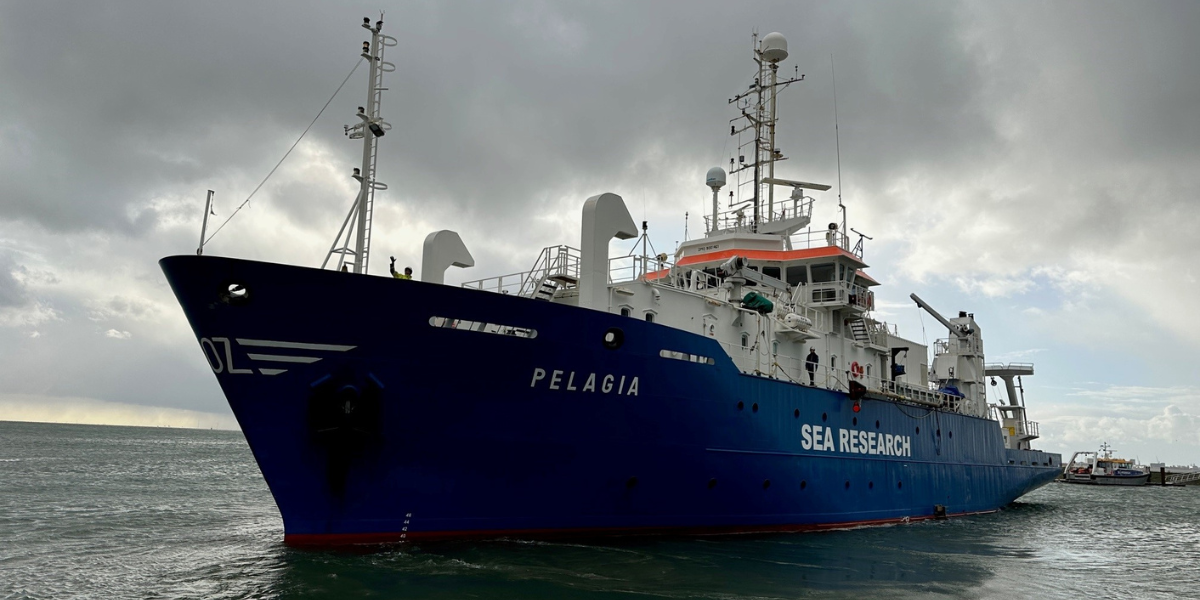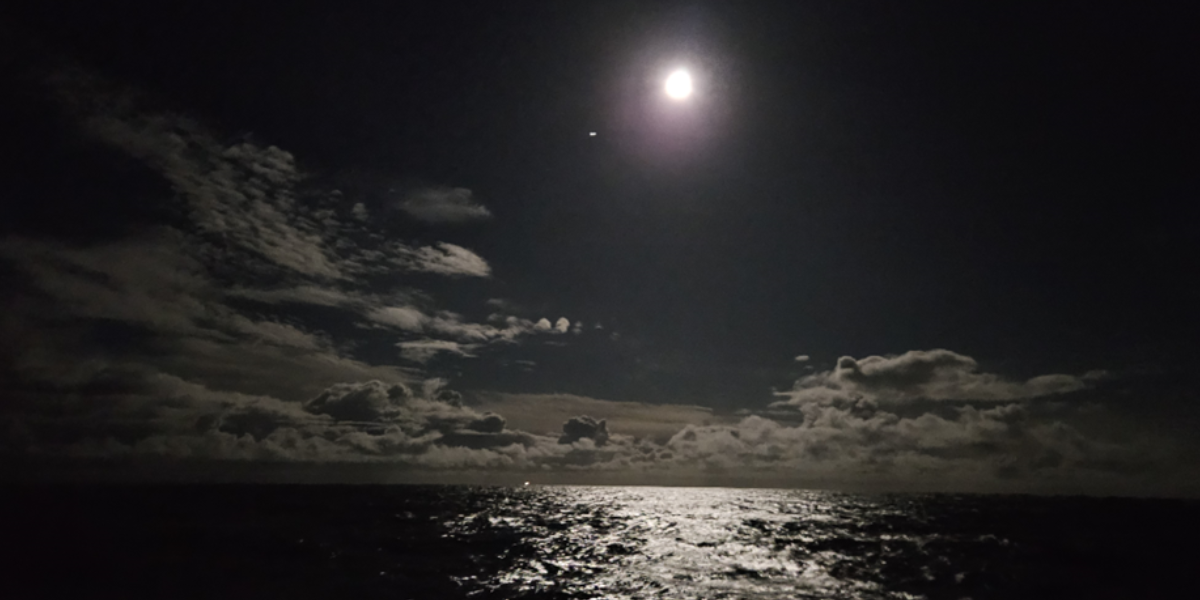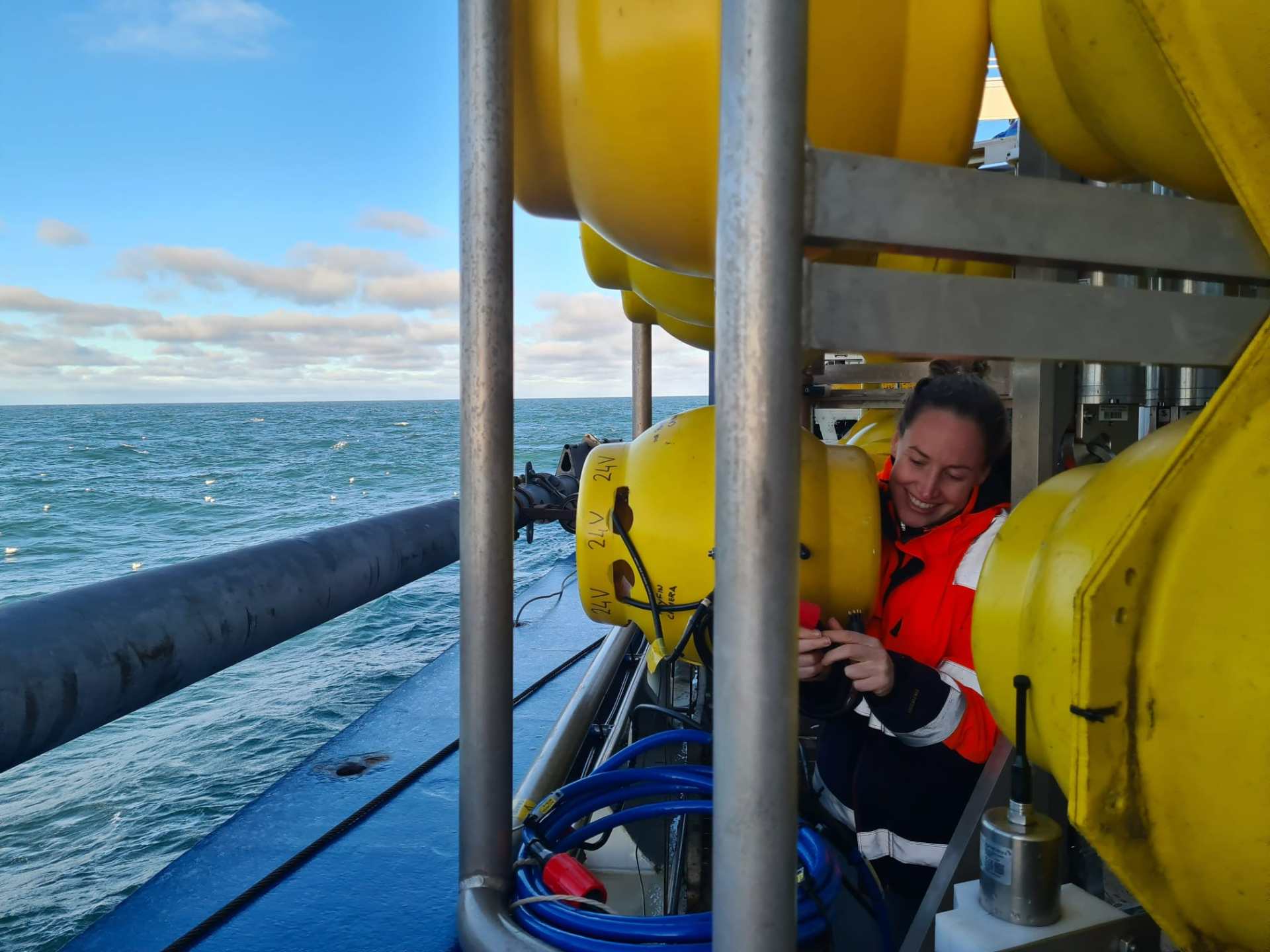
3 November 2023
By Helge Niemann
We are back, the sea is on the other side of the harbour pier. 17 days at sea and one day where storm Babet forced us to leave our target and to seek shelter in the harbour, are behind us. A time where we basically breathed science 24/7. We sailed almost a thousand miles, deployed a multitude of instruments at 87 stations, took subsamples, incubated samples, watched screens where scans of semi-autonomous probes delivered a real time glimpse of North Sea’s interior. We discussed the newest measurements and how to optimise our workflows to make the best of the precious time. We were in awe about the video footage we received during dives with the ROV (a remotely controlled submarine). All of this is in the past - but only for now.


After a round of proper sleep, meeting friends and family from whom we have been separated, will meet. Some in person, others will connect remotely. The group will be bigger, not only comprised of the scientists that were on board but also others for whom we took samples and condicted measurements. We will discuss what steps are necessary and how to best achieve our goals. Not everything worked out as planned – in fact many strategies had to be implemented ad hoc because of weather and technical constrains. But already now, we can say that the expedition was a success. The first glimpse on our data promises plenty new insights about the dynamics of methane release in the vicinity of abandoned wells. But firstly, there is still a lot to do: data need to be analysed and cross checked, DNA needs to be extracted, sequenced and interpreted. Thousands of samples have to be measured on specialised machines at NIOZ, TNO and elsewhere.
Meanwhile, the crew is already getting Pelagia ready for the next expedition that will lead another groups of scientists to new horizons - after an expedition is also before another expedition.

27 October 2023
By: Noortje Versteijlen
About 4,5 years ago I started at TNO’s Advisory Group for Economic affairs (AGE) as a geologist/advisor energy transition. My very first project was related to Parliamentary questions about potential leakage of wells drilled through ‘shallow gas’ in the North Sea. At that moment I did not know that years later I would be on a research vessel doing measurements above these wells.
First some background on the topic. Natural gas is a common occurrence in the Dutch subsurface. Methane is the ‘main ingredient’ of natural gas. It’s a potent greenhouse gas, but as long as the methane stays in the subsurface, it doesn’t contribute to climate change. However, some of the methane finds its way to the surface and is released into the atmosphere. This can be a natural phenomenon, or it can be man-induced. One of the well-known natural processes occurs in peat grasslands, where you can observe methane gas bubbles rise in the famous Dutch canals.
We focus on ‘shallow gas’ In the North Sea as the source of methane emissions. Shallow gas is natural gas that is found in the upper 1000 m of sediment. These sediments are loose sands and clays. The gas is found in between the sand particles when an overlying clay layer is posing a barrier for the upward migration of the gas (gas want to move upward due to buoyancy). However, these clay layers are not perfect seals and some gas ‘escapes’ upward, while at the same time gas accumulates remain in the subsurface. This results in the occurrence of natural seepage areas (gas bubbles coming from the seabed) above gas accumulations that are so large that they are being produced by oil and gas companies.
Since a couple of years there is an ongoing debate on methane emission from decommissioned or abandoned well. If gas bubbles occur in an area where abandoned wells are located, the question is whether it is a result of well leakage (i.e., leakage resulting from improper construction or abandonment of the well) or whether natural processes play a role. During last year’s expedition we did a lot of methane measurements at different locations in the Dutch North Sea (both abandoned wells and natural seepage sites), to gain more insight into to both phenomena. Now we are back at a couple of locations to investigate how much methane is released into the water column and eventually into the atmosphere.
So that’s how I, as a geologist, am trying out my sea legs. It started about two weeks ago and I can say that my sea legs have been put to the test by storm Babet. And with success! We had high waves and were forced to take shelter. After a few days in the harbor of Texel we continued the measurements. I am working with the lander and with hydro-acoustics. The lander is a frame with different sensors and cameras that is placed on the seabed near a bubble plume. The goal is to film the bubble plume and to measure dissolved methane levels, salinity, pH, the water current and oxygen levels in the seawater for a couple of days. It is my responsibility to make sure that de sensors and cameras are well programmed and up and running before deployment. A couple of days ago we successfully retrieved the lander from the first location (leaking well) and deployed the lander at another location (natural seepage location).

My second task is to get acoustic water column data from areas with methane bubbles with a so-called multibeam - and singlebeam echosounders. It works similarly to a baby ultrasound, but we image gas bubbles in the water column instead. This way we can exactly pinpoint the bubble locations and it enables us to measure the methane volumes. These measurements happen during evening/night between 20:00 and 08:00, but luckily, I shared the first shift with my beam-buddy Henk de Haas from NIOZ since it was new to me. With the help of lots of snacks we got through the early hours. Now I know how the equipment works, and we switched to alternating shifts, which allow us to catch some more sleep. Although it sounds tough to work during the night, it is a surreal experience to be on a vessel floating in the dark in the middle of the North Sea.
Time goes by very quickly and we only have a few days of measurements left. This expedition and working with the crew is a great experience and I will miss it when I’m back on shore.
27 October 2023
By: Annalisa Delre
First time on Pelagia, what an excitement! Although, honestly, I wasn't so happy when I read 'Methane cruise, end of October'. The North Sea is famous for being unpredictable in October, and it obviously did not disappoint us/me. After a bit of a bumpy start, we still managed to collect several samples and already got some exciting results.
I am in the second year of my PhD and now find myself in the middle of the Dutch North Sea searching for methane bubbles. Methane is the second most important greenhouse gas, after carbon dioxide, and its atmospheric concentration has been increasing dramatically since the industrial revolution, thus contributing to climate change. Knowing the global budget is important for making a change, and emissions from ocean sources are relatively low, but the uncertainty of actual emission numbers is very high. We especially don’t know too well how much is emitted as side effect related to hydrocarbon extraction offshore – this is poorly is poorly constrained in global budgets. We already know that abandoned offshore wells may leak: but, how much methane ends up in the water column? How much reaches the atmosphere? Can microorganisms help reducing methane emission by basically eating away methane before it is liberated to the atmosphere?
This cruise will help us answering these questions. For now, I can say that bubbles can be seen from the sea surface, but I will know more once I have analysed my samples back at NIOZ. It is a pleasure to have a team that is helping me with the intensive sampling: Pepien Rubbens, Robin van Dijk, Jessica Riekenberg, Jesper Volmer and Yasmina Ourradi. And it is great to work with Pelagia’s crew, who, despite the hard work out here, always manage to put a smile on our faces and keep our spirits up.

22 October 2023
By: Ilona Velzeboer
As a climate and air quality scientist at TNO, I like to measure methane. I do that a lot onshore, with a mobile truck. Now I got the chance to do this also offshore. For this campaign at RV Pelagia at the Dutch North sea, I used a container from NIOZ to built a mobile lab (with help of highly appreciated colleagues) to be able to measure methane, both from the water phase, as also the emission to the atmosphere.
With help and expertise of the technicians of NIOZ we made a floating chamber (“the donut”), to be able to measure methane that emits from the water phase to the air, directly with a laser spectrometer.

Furthermore, also with the help and expertise of the technicians of NIOZ, we made a “SLURF 2.0”. An improvement of the “SLURF” that we used last year. The improvement is that this time there is a funnel attached to a hose, which can be placed on top of a bubble plume with the help of a ROV. A pump is used to bring the water into the container, where the water is going through a membrane to separate the methane from the water. The methane concentration is directly measured with the same laser spectrometer, as used for the floating chamber, as we can switch the system between the SLURF and DONUT measurements.
Next to these measurements, I also brought an extra instrument which continuously measures the atmospheric concentration of methane, CO2 and CO. The inlet and GPS corrected 2D sonic anemometer was placed in the front mast.
The first measurements at the North sea worked out well, so lets continue in between the periods with a bit too high waves, to perform more SLURF and DONUT measurements and contribute to this impressive measurement campaign!

20 October 2023
By: Pepien Rubbens
I am writing this blog post back on Texel, not because the cruise has already ended, but because we are seeking shelter from a storm that crosses most of the North Sea. Yesterday we sailed back through the night while large waves hit the bow lifting us from our mattresses. It was a bumpy ride.
My name is Pepien Rubbens, a Marine Sciences master student at Utrecht University. I am doing my master thesis project here at NIOZ, working on plastic degradation through microorganisms.
Every day, huge amounts of plastics enter the ocean and it is not clear what exactly happens with that plastics. Does it all stay in the ocean, or is some of it degraded? It has been shown that some marine microorganisms can degrade plastics, but there are still so many unknown factors about this process, for example: how fast does this happen, and what plastic types are more likely to be degraded? At the sea surface, plastics are also affected by solar UV light. This makes plastic brittle, making it more ‘tasty’ for microbes to feed on. To study this process, I use special plastics that are labeled. I’m adding this to the seawater samples that I collected during the cruise. When the microbes degrade the plastic, the CO2 will also be labeled because this is the end product of microbial degradation.
Next to my project, I’m part of the CTD team on this cruise. A CTD is a device that can sample seawater at specific depths and it continuously measures the amount of salt and the temperature in the ocean. For this, I am up in the CTD room checking the depth and measurements of the CTD to communicate this to the people controlling the device. The water that we sample will then be used by other scientists to investigate methane – the main objective of this cruise.
Besides the scientific experiments, it has also been a really cool experience being on a research vessel in the middle of the North Sea. Experiencing the power of the waves crashing over the bow of the boat and watching the sunrises and sunsets on board has been amazing. Talking to the chief officer about the many things that go into navigating a vessel like the Pelagia and seeing them work on the bridge of the ship has also been very interesting. Although the powerful sea makes you feel very small on a boat, looking towards the horizon at sea has a very calming effect on me. I am curious about what the next part of the cruise will bring after we depart from Texel again tomorrow!

19 October 2023
By: Helge Niemann
22 hours to station
The first days of the cruise were rough – stormy seas. R/V Pelagia, the flag ship of the Netherland’s research fleet is our home for the next two weeks. She fights her way through high waves and howling winds towards the central North Sea. There, we want to investigate methane, one of the most potent greenhouse gasses.
This gas evolves at greater subsurface depth and can percolate through sediments towards the seafloor from where it may bubble into the water column. But how much methane is actually released from the sea floor? How much is consumed by microbes in the water column and how much is finally ending up in the atmosphere where it heats up our blue planet? These are the central questions of our expedition.
We are coming well equipped to sample waters and sediments with an arsenal of probes, remotely controlled under water vehicles and autonomous landers. But for now, Pelagia is rolling through the waves, we are living on a giant shaker, everything is moving from left to right and front to back. It is difficult to sleep at night, and only a few faces appear at the breakfast table, some remain seasick in their cabin.
But soon, the ship will become busy - probes and samplers will be programmed, labs will be prepared, and the equipment get their last modifications and final touches in one the ship’s workshops. The air will become almost thick with anticipation, not only on the boat but also on land: many people have worked hard in the last month to make this expedition possible, the scientists and crew on board, but also engineers and support staff at NIOZ, our home base.


